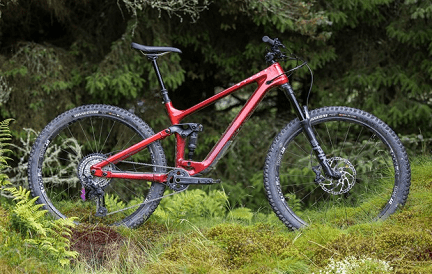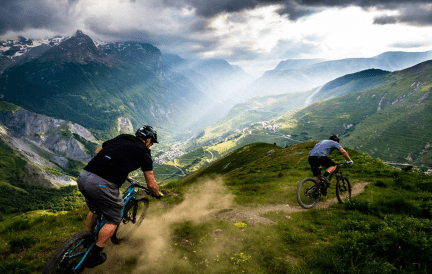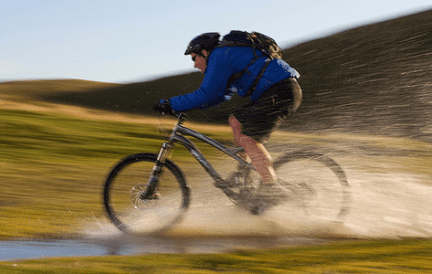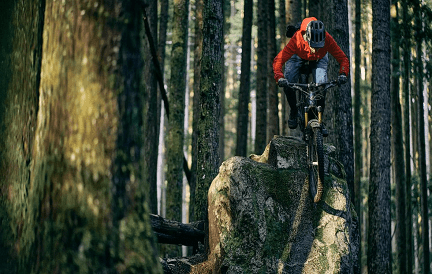Mudguards are necessary for urban downhill bike races. It prevents the rider from being wet and moist at the end of the race. Install a mudguard on your urban downhill MTB for a convenient dry ride. It keeps you dry and neat even after a ride through muddy terrains.
- Part 1: General Overview of Mountain Bike Riding
- Part 2: Pros and Cons of Mountain Bike Riding
- Part 3: Cautions for Mountain Bike Riding
Part 1: General Overview of Mountain Bike Riding
Mountain bike riding is typically traversing off-road terrains with a mountain bike. It is a physically exerting sport. Commonly used off-road terrains include mountains as well as deserts. The categories in mountain bike riding include Cross Country Mountain Biking, Short Track Cross Country Mountain Biking, Ultra Endurance Mountain Bike Racing, Downhill Mountain Biking, Four Cross as well as observed trials.
Mountain bike riders usually take their tools along with them for quick repairs if their bike develops a fault or they have a flat tire. Mountain bike riding is a sport that requires a lot of endurance and self-trust.

The sport originates in California in the 1970s. It wasn’t initially a national sport. It eventually picked up popularity and drew the attention of the media. Mountain bike riding made its first entrance into Olympics during the Atlanta games via the category of Cross Country Mountain Biking. It featured both male and female categories.
Part 2: Pros and Cons of Mountain Bike Riding
Pros
Mountain bike riding has a lot of pros, especially in the area of health.
Full Body Exercise
The defined calves of a cyclist are quite obvious. The fact actually is that cycling utilizes the entire muscles. Riding a mountain bike on an urban downhill builds strong legs, thighs, calves, and also the glutes. The balance required to stay upright strengthens your core muscles. Climbing and maneuvering turns while riding also strengthens your upper body. Due to obstacles, tough terrains, and challenging courses, mountain bike riding is regarded as a good cardio exercise that is beneficial to the heart.
Family Bonding
Urban downhill mountain bike riding helps forge a stronger bond between family members. It’s a great way to have fun with the family, and it brings a sense of unity amongst people. Mountain biking is basically a social activity shared by different people who don’t necessarily have to be family but get to ride together. It provides the atmosphere to build interpersonal bonds and make new friends with people who enjoy the same activities you do.
Reduced Stress in Joints
Mountain biking is regarded as a low-impact sport, as less stress is directed on your joints than other aerobic activities. urban downhill mountain bike riding is considered a non-load-bearing sport, which means that sitting takes the pressure off your joints and reduces the risk of injuring them. Mountain bike riding helps to keep the muscles flexible and healthy. The reduced stress on the joints makes it one of the best forms of exercise for people suffering from osteoarthritis.
Reduces Stress
Riding an urban MTB downhill requires a lot of concentration from your mind. This action causes your body to release endorphins which are also known as happy hormones. The release of these hormones helps to reduce stress and improves your state of mind. Focusing on the road helps take your mind off negative things, and this helps reduce anxiety.
Healthy Appetite
After a very tiring downhill mountain bike ride, you will definitely want to eat the right foods. There is improved information available on foods that can provide the energy you need while riding and how you can guarantee the benefits with a post-ride meal or snack.
Mountain biking will increase your appetite. Further, with the calories you’ve burned, you can safely take on a large portion, but you must always remember to eat your greens.
Reduces Risk of Health Problems
Exercising regularly is known to be a good way of boosting your immune system. Mountain bike riding has a lot of health benefits; being an outdoor activity, it increases exposure to daylight and helps aid the body in the production of vitamin D. Studies have shown that mountain bike riding helps to lower the occurrence of breast cancer in women. The fact that it gives a full-body workout helps you to maintain healthy body weight and protects you against obesity-linked health problems.
The heart and lungs make up the human cardiovascular system, and the fitter you become, the better they work. This means an improved flow of blood through your body and an increase in oxygenation. Your fitness level depends on how well you carry out this process. By increasing your training on your bike over time, there is an associated improvement in the functioning of your cardiovascular system and, therefore, fitness level.
Improved Coordination
Balancing on two wheels can be difficult at times, and doing it while going down a steep, rocky section on a trail is a different experience altogether. This can have a positive effect on balance, which can have further positive influences on your health. Riding any kind of bike will improve balance, however, mountain biking enhances this even further due to the fact that the terrain is inconsistent. Riders must constantly adjust to the dynamic, changing landscape.
Hobby Building
Having a hobby allows you to relieve stress and focus on something not as mentally draining. Studies have shown that less stress leads to better sleep and easier control of your emotions. In addition to being a thrilling hobby, there are some great people to meet and even make friends with while biking. Mountain bike riding is a great hobby to possess.
Improved Brain Power
Mountain bike riding causes extra stimulation in the brain and helps it grow. The urban downhill bike requires control and very good concentration. Mountain bike riding helps increase specific areas of the brain responsible for thinking, learning, spatial memory, and decision making. Learning new skills is easier and faster with a healthier brain. It also helps reduce the risk of degenerative diseases in the future. Sustained practice at this helps to strengthen neural pathways and reinforces muscle memory.
This stimulates the brain further and promotes a healthy relationship between the resources of the brain, the nervous system, and the muscles. Regular mountain bike riding can help build brain cells in the hippocampus, which is the part of the brain that is responsible for memory. Exercise can help boost the supply of blood and oxygen to the brain, which helps to regenerate the receptors in the brain and can help ward off Alzheimer’s disease at a later stage in life. Mountain bike riding also helps build sharp reflexes because you must be ready to think fast when facing obstacles along challenging trails.
As people get older, the improved balance will help to prevent falls which could lead to injuries – including broken bones and fractures.
Cons
Although there are lots of advantages of mountain bike riding, there are also certain disadvantages, most of which appear if proper safety measures are not taken. Mountain bike riding has the following cons
Cost
Mountain bike riding can be a bit expensive when you take into account the cost of safety gear. It sometimes also requires unplanned repairs. A bike is not all that’s necessary to ride a mountain track. Regular maintenance costs add up over time. Bikes require regular adjustments, alterations, and repairs which can be expensive if you can’t do it yourself.
Accidents
Mountain bikes can be susceptible to accidents. They do not have the build and shielding of cars, and they possess thin tires. A distraction while riding or any sudden change can be dangerous while riding. Even the most experienced drivers can slip and lose control. Rough terrains constitute a significant cause of mountain bike accidents
Nerve Injury
The neuropathy of bicycle seats is a common cause of injury to mountain bike riders. The injuries are mainly due to bikers trying to support their weight on the seat, and this is believed to be associated with vascular or neurological nerve injury. Therefore, mountain bike riding must be done with care.
Addiction
Mountain bike riding can be an addictive sport for thrill-seekers who can’t do without the adrenaline rush. It can also bring about unhealthy competition when you stop doing it for fun and start some unhealthy form of competition with fellow bikers.
Part 3: Cautions for Mountain Bike Riding
Proper Equipment
You must use well-fitting personal protective equipment while riding a mountain bike. Such equipment, which includes helmets, body armor, and mouth guards, helps to reduce your risk of injury. Helmets help to reduce the risk of traumatic brain injury and fracture of the skull. Using body armor in the lower limb helps to reduce the risk of injury to the area.
Mountain biking gear is quite similar to other riding activities but there are a few important differences. Most mountain bike riders wear two layers of shorts, the first layer being fitted padded shorts commonly known as chamois, with a loose-fitting pair of thin cargo-like shorts on top. Wearing mountain bike-specific shoes hardened with a toe box is always better because hitting toes on rocks is a relatively common injury in the sport. Safety gears like gloves, body armor, and knee and elbow pads can protect the most susceptible areas and reduce the effect of accidents if any.
Training
You must have training before taking on mountain biking as a sport, as this will help educate you on the causes of injury n the sport. It’ll teach you to ride within your skillset.
Engage in Sport-Related Exercise
Mountainbike riding is a physically demanding sport, and as such, having some pre-existing health conditions can increase the risk of injury. You must have a full-body physical evaluation to ensure fitness to participate in mountain bike riding.
Familiarize Yourself with the Trail
Get to know the trail by traversing on foot to figure out the blind corners to rule out any surprises while riding. When riding a track for the first time, take it easy as taking risks might end up being dangerous. A new trial might be filled with obstacles that might be beyond your skill set.
Avoid Riding at Night
It is not appropriate to go mountain bike riding at night. The reduced visibility at night can be fatal to a mountain bike rider. You’d better to have urban downhill MTB riding during the day.
Carry a First Aid Kit
Mountain bike riding at speed in rocky or wooded terrain can result in broken bones or bruises, hence the reason to wear a helmet. However, evidence suggests that most mountain bikers don’t carry a first aid kit with them. If your collarbone gets broken, a triangular bandage can help make a sling. Wound dressings, pain killers, plasters, antiseptic wipes, and latex gloves would be very useful.
Bike Maintenance
Whichever choice you make about the type of bike you ride, the more you use it, the more maintenance it will need. No matter how expensive or inexpensive your bike is, you need to maintain it. Off-road riding can take a toll on the bike, especially in wet and muddy conditions. It is necessary to keep your bike at least very clean and keep its moving parts lubricated to prevent wear and tear caused by friction. A properly maintained bike performs better, and its components will last longer.
During the summer months, when it’s dry, some paths and trails can develop a layer of fine dust due to the lack of moisture in the ground, which combined with ordinary chain oil, produces a highly effective grinding paste that will ruin your bike’s drive-train. Appropriate lubrication reduces this phenomenon.
Don’t Go Astray
Many mountain bike riders now use a Global Positioning System for navigation, and there are a number of biking-specific GPS systems on the market. GPS systems can make direction-finding easy and accurate. But they’re not cheap, and they’re not flawless. In the event that there is no GPS, a map and compass are just as helpful to mountain bikers on untried trails as they are for walkers, although very few of the former seem to carry compasses. For many mountain biking trails, there is little or no waymarking. It can also be easy to lose your way, especially in forested areas. A compass can help prevent you from heading miles off course.
Drink Enough Water
Always make sure you carry enough water when you go mountain biking, especially during the summer and on longer rides. Many mountain bikers use hydration packs, a water bottle with a drinking tube, usually with two or three liters volume, carried in a specially designed small backpack. Hydration packs allow you to carry more water than ordinary bottles carried in frame-mounted bottle cages which are more popular with road cyclists – that can easily be dislodged when riding off-road. Urban downhill MTB activities can be strenuous; be sure to be sufficiently hydrated before setting off on your ride.









